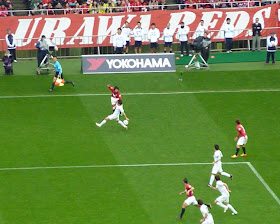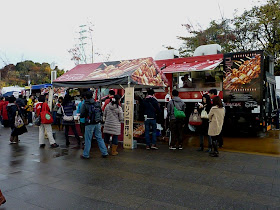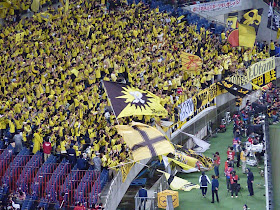These matches are relatively easy to see because they occur in championship series so you just have to show up, pay the exorbitant ticket price, and regardless, one team will eventually take the title. The situation is a bit different in soccer. League titles can be decided before the season is over, or you can have multiple teams in contention on the last day of the season, so you have to be in the right stadium at the right time.
Such was the case in the J League this year, with 3 teams in contention on the final matchday. Kashiwa Reysol had a 1-point lead on defending champions Nagoya Grampus, while Gamba Osaka was just 2 points back. Fortunately for me, Kashiwa was visiting the Urawa Reds in Saitama, close enough for me to venture up on Saturday afternoon to see if they could hold on for the crown.
Saitama Stadium 2002
Opened in 2001 for the 2002 World Cup, Saitama Stadium 2002 is one of the largest football-only venues in Asia. It hosted 4 matches in that World Cup, including England's 1-1 draw with Sweden and Brazil's semifinal win over Turkey.
The stadium is located about a mile north of Urawa-Misono station (which commemorates the World Cup with the mural above), which itself is a 45-minute ride from the center of Tokyo, on trains that get very, very crowded. There are shuttle buses from the station, but I prefer to walk along the footpath as there are concession stands along the way and you can appreciate the size of the stadium as you approach. There are also meter markings along the way so you know how far you have left. I don't think you save much time with bus anyway, as the lineups to board were huge.
Outside the stadium is a large plaza with a number of food trucks serving a wide variety of Japanese and western food. There are also a sizable number of plastic tables on which to eat, so you can relax to enjoy your meal. I highly recommend you arrive early and choose one or two of these culinary choices as it is going to be far better than the food you get inside. My favourite was the yakitori spot below, called Nihonichi, which served a good variety at 100 yen a stick.
Tickets here are reasonably priced for Reds games, with the best seats going for just 4,500 yen and the unreserved seats just 2,000 yen. The stadium is divided into four quadrants (A, B, C, D) that are colour-coded, with A and C along the sides and B and D used for the end zones.
You can enter the lower concourse via any gate and walk around, as long as you are not wearing the visiting kit. I recommend you do this as there are a number of displays that recall those heady days of the World Cup. I worked at this stadium for those games and it was rather nostalgic to see the memorabilia still on show.
In order to reach the upper deck, you have to enter the specific gate on your ticket and walk up several flights of stairs. The ticket also includes which specific aisle to use, which is important as there are limited walkways in the seating bowl, which makes getting out after the game a real hassle.
The home fans occupy the lower deck in the north end of the stadium, while the visitors are confined to a small area on the south side. Even then, fans of both squads were interspersed in the other sections, I was surrounded by yellow-clad Kashiwa supporters on one side, while Red rooters were on the other.
As this is a football-only venue, the seats down below are close to the action and make for a good investment, if you can get them. Even the upper deck seats are good, although I was at one end, which was not the best. There is plenty of leg room here, and no problem seeing the field with the upper deck rather steep.
The stadium is one of the most attractive in Japan, which is used to seeing functional but boring arenas. Here, the upper deck seats taper from the center to the end zones and are covered by curving roofs, while the end zones are open. This allows views of the surrounding countryside from the upper deck, although there isn't much to see.
From a distance, the stadium reminds me of Miller Park in Milwaukee with its roof open, but it is just an illusion, the two roofs do not approach each other at any time.

Overall, Saitama Stadium is a great venue to watch soccer. The proximity of the seats allow the supporters to be part of the game, and the unique architecture and souvenirs from 2002 make it a special place for students of the game. The only problem here is the access - it is far from the city, far from the station, and there are not enough walkways or washrooms. Keep that in mind if you ever decide to pay a visit here.
The Teams
The Urawa Red Diamonds are one of the best-supported teams in Asia, averaging over 40,000 fans per game over the past few seasons. Winners of the League and Emperor's Cup in 2006, the Reds were the fourth Japanese club to achieve Asian glory, taking the AFC Champions League title in 2007. Lately though, they've fallen into disarry, and they lay 15th out of 18 teams this season. They were technically in danger of being relegated if they lost, but they needed the 16th-place team to win by 13 goals if they lost by 1, so it was unlikely. Their fans are famous for their boisterous displays and provide terrific atmosphere in this large stadium.
Kashiwa Reysol were the champions of J2 last season, earning automatic promotion back to the top league. This season they had been near the top of the league since the beginning, along with 3 other clubs. After 23 rounds, Kashiwa lay fourth, behind Gamba, Nagoya, and Yokohama F. Marinos. But an 8-1-1 record from there put Reysol in first with just one match day to go. It is unheard of for a promoted team to challenge for the league title but that was just what Reysol had done; in a season where no squad dominated, they were the most consistent, with 22 wins and 3 draws from their 33 games. Both Nagoya and Gamba had better goal differential, so Reysol needed a win to ensure the crown, a draw would not be enough.
The Game
The morning started with heavy rain, but by game time, it had cleared, though the field was still slippery. As I took my seat, I could feel the tension in the air; the Reysol faithful were nervous being so close to their first league title. Although Urawa were not the powerful side from years gone by, they had their home fans urging them on. I expected a good game and was not disappointed.
It was clear early on that Kashiwa were the better team as they attacked continuously, only to have their shots go wide or over the net. It wasn't until the 29th minute when Jorge Wagner took a corner kick that was first saved by a defender, then booted off the post. The ball bounced out to Wagner who was running in from the corner untouched. He blasted a shot that would have missed but it bounced off the leg of keeper Nobuhiro Kato and through his legs to make it 1-0 Reysol.
Nine minutes later, another Kashiwa corner fell to defender Wataru Hashimoto, who tapped the ball over his head with his back facing the net. Kato was caught well off the line and Hashimoto had his first goal of the season and it looked like Reysol were well on their way, up 2-0.

The second half saw Kashiwa look tentative early on, and Urawa took advantage when an innocent-looking cross found the head of Yosuke Kashiwagi, who put the ball in the upper right corner of the net to cut the Reysol lead in half.

The rest of the game was mere prelude to the postgame party. There were no chances on either end as the teams played out the last few minutes with Reysol knowing they were about to be crowned 2011 J League Champions.
The Celebration
When the final whistle blew, the Reysol players collapsed in exhaustion on the field while the substitutes raced over to commence the group hug. Manager Nelsinho Baptista was given the traditional do-age (pronounced doh-a-ge), where the coach is tossed in the air three times.
The players then went to their supporters and bowed in appreciation. When it was time for the trophy presentation, they gathered around a small sign declaring them champions, and were presented with the championship plate, which they held up to the crowd (below). I was on the wrong side of the stadium to get a good picture, but you can see it is not a big trophy by any means.
The players returned to the front of their supporters section and a different group of players raised the plate to raucous cheers. Then it was over. The players filed off and that was it. The whole thing took maybe 15 minutes and was rather anti-climatic compared to the championships in North America.
Notes
After Kashiwa cleared the field, the Reds players came out for a final goodbye. Team president Mitsuo Hashimoto spoke and I was shocked at the hatred the fans had for him. The booing was loud and incessant, lasting from the moment he appeared until the stopped speaking. Check out this video for the evidence.
On the way back to the station, the Kashiwa fans were quiet, talking about their team's chances in the upcoming Club World Cup tournament or next years AFC Champions League. There were no drunken louts screaming, no fights, no riots, just happy fans basking in a hard-fought championship. On the train home, you wouldn't have guessed that their team had just completed a historic season, they all sat quietly and studied their smartphones.
That's one difference between fandom here and there. In Japan, the fans give it all inside the stadium, screaming and yelling for hours, but once the game is over, they revert to their normal, quiet selves. Back home, fans cheer long after the game is over, usually getting smashed in the process, and often smashing other things. I have always complained about the lack of real emotion exhibited here at sporting events, but as sports in the States has become consumed by hype, I find that I now prefer the self-control exhibited by fans here. I'm all for having a good time but too often it comes with a heavy price, with damages to a city's reputation taking far longer to repair than damages to a few shop windows. I'm sure there's a happy medium here, but not sure how it can bee achieved.
Update: Minutes after I posted this, I read about 13 fans being injured rushing the field after Oklahoma State's Big 12 championship win. I hate college football for so many reasons, and this episode just adds to the list. It also illustrates my point - hype drives college football now, so fans think it is actually meaningful to win a championship in a conference that features 3 or 4 competitive teams, so much so that they rush the field and tear down goalposts without regards for the safety of others. Is there no perspective left in American sports?
Next Up
I'm flying to France shortly for a 2-week roadtrip that doesn't involve sports. I'll be back in Japan for the new year and planning all my 2012 trips. Check back then for an exciting announcement about me going to see more Maple Leaf road games.
Best,
Sean

















No comments:
Post a Comment